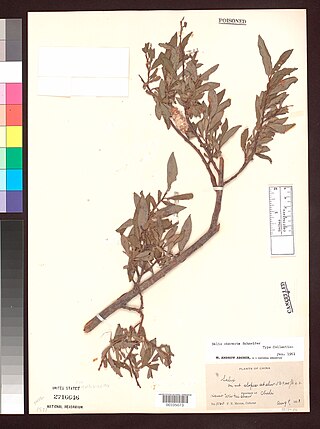
Salix aegyptiaca, known as the Persian willow, is a large shrub or small tree from the genus of willow (Salix) with red branches that are tomentose in the first two years and leaves up to 15 centimeters long. The natural range of the species is in the Caucasus and in western Asia. It is cultivated in many countries.

Salix argyracea is a large shrub from the genus of willow (Salix) with up to 10 centimeters long leaf blades with a felty hairy and shiny underside. The natural range of the species is in Kazakhstan, Kyrgyzstan, and China.
Salix capusii is a large shrub from the genus of the willow (Salix) with chestnut-brown branches and 4 to 5 centimeters long, gray-blue leaf blades. The natural range of the species is in Afghanistan, Tajikistan, Pakistan, and China.
Salix balfouriana is a shrub or small tree from the genus of willow (Salix) with reddish black and tomentose hairy young twigs and up to 8 leaf blades, rarely 18 centimeters long. The natural range of the species is in China.
Salix annulifera is a small shrub from the genus of the willow (Salix) with up to 8 centimeter long leaf blades. The natural range of the species is in China.
Salix boseensis is a shrub from the genus of willow (Salix) with initially brownish, frosted and bare branches and 6 to 9 centimeters long leaf blades. The natural range of the species is in China.
Salix anticecrenata is a low, pillow-shaped shrub from the genus of willow (Salix) with about 1.5 centimeters long leaf blades. The natural range of the species is in Nepal and China.
Salix atopantha is a small shrub from the genus of the willow (Salix) with up to 4 centimeters long, dull brown leaf blades on top. The natural range of the species is in China.

Salix bhutanensis is a shrub or small tree from the genus of willow (Salix) found in Nepal, Bhutan, and Tibet. It has young, densely brownish green tomentose hairy branches and 3 to 5.5 centimeters long leaf blades.
Salix contortiapiculata is a tall shrub from the genus of willow (Salix) with 5 to 9 centimeter long leaf blades. The natural range of the species is in China.

Salix cavaleriei is a large tree from the genus of willow (Salix) with a gray-brown, furrowed bark. The leaf blades have lengths of 4 to 11 centimetres. The natural range of the species is in China. It is planted for logging and for fastening embankments.

Salix characta is a shrub from the genus of willow (Salix) with initially downy hairy branches. The leaf blades have lengths of 3.5 to sometimes 7 centimeters. The natural range of the species is in China.

Salix cheilophila is a shrub or small tree from the genus of willow (Salix) with initially tomentose hairy and later balding branches. The leaf blades have lengths of 2.5 to sometimes 6 centimeters. The natural range of the species is in China.
Salix crenata is a cushion-shaped growing shrub from the genus of willow (Salix) with about 8 millimeter long leaf blades. The natural range of the species is in China.

Salix cupularis is a small shrub from the genus of the willow (Salix) with 1.5 to 2.7 centimeters long leaf blades. The natural range of the species is in China.
Salix delavayana is a shrub or small tree from the genus willow (Salix) with mostly 3 to 8 centimeters long leaf blades. The natural range of the species is in the south of China and in Tibet.
Salix dibapha is a shrub from the genus of willow (Salix) with mostly 4 to 6 centimeters long leaf blades. The natural range of the species is in China.
Salix dissa is a low shrub from the genus willow (Salix) with usually 1 to 3 centimeters long leaf blades. The natural range of the species is in China.

Salix driophila is a shrub from the genus of willow (Salix). The natural range of the species is in China.
Salix blakii is a willow (Salix) shrub with thin, brownish and bare branches and 4 to 8 centimeters long leaf blades. The natural range of the species extends from Southwest Asia to China.







